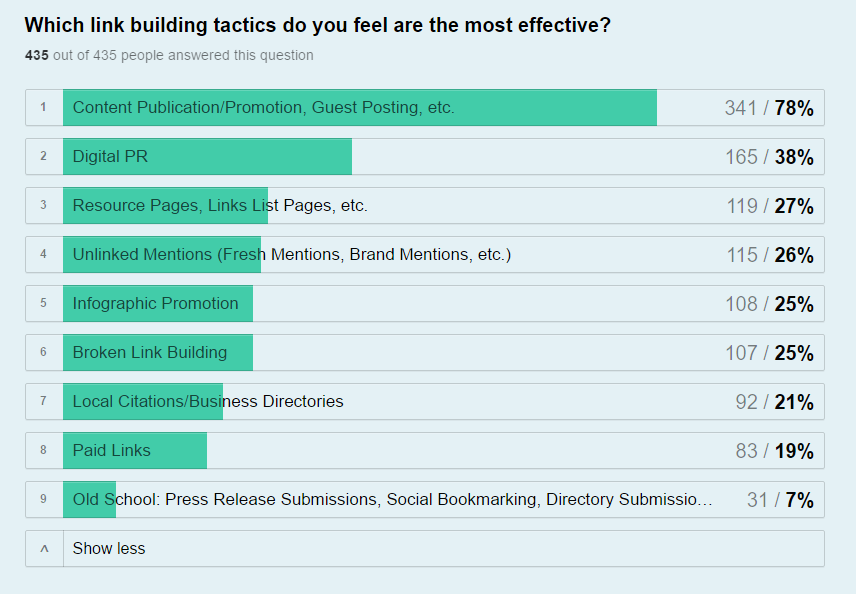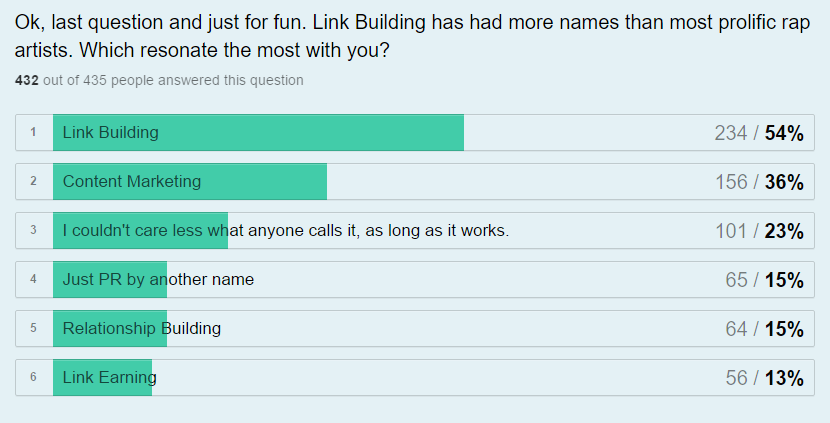2016 state of link building survey: five important takeaways
Links are still one of the most important ranking factors in Google search.
This was confirmed as recently as March, when Andrey Lipattsev, a Senior Quality Senior Strategist at Google, revealed links, content, and RankBrain as the top three most important ranking factors.
This wasn’t surprising information (at least to SEOs), but it was an important confirmation. Links and content are still the fundamental building blocks of the web.
But what is the state of link building? We know links matter greatly to search, and that competitive search requires links. Brian Dean of Backlinko analyzed 1 million Google Search results and found “the number of domains linking to a page correlated with rankings more than any other factor.”
And BuzzSumo and Moz also found that within a sample of 750,000 well-shared articles over 50% had zero external links.
Links matter, but it’s not as simple as hitting publish—or even promoting and achieving recognition on social platforms.
With that in mind, my fellow Page One Power colleague Nicholas Chimonas teamed up with John Doherty of Credo to create a 2016 Link Building Survey which was published on Moz on Tuesday 5 April.
Nicholas, John, and Moz all used their considerable influence to reach as many people as possible.
Nicholas, John, and the editors at Moz (namely Felicia Crawford) spent time digging into the data and pulling out the pertinent information. It’s a long, thorough post and I highly recommend you go read it once you’re done here.
But instead of rehashing that information, I’m going to pull out my own top five takeaways from the 2016 Link Building Survey.
The survey had 435 respondents.
Of those 435 respondents, 180 were agency, 118 in-house SEO, 51 consultants and freelancers, 41 business owners, 39 in-house content marketers, and 6 in-house PR.

These respondents serve a variety of clients, with a majority selecting SMBs and a smaller sampling (106 respondents) highlighting enterprise level clients.

As you can see, the sample size is fairly varied.
Let’s get into the takeaways…

There are two competing truths in the SEO world: every website needs links to perform well in search, and it’s hard to put a price on links.
On one hand, it’s difficult to guarantee links. Every SEO is armed with a wide-variety of diverse tactics which can result in links, but what’s effective varies greatly from client to client and niche to niche.
Securing links is often time consuming, difficult, and requires specialized knowledge. That inherently makes it a valuable skill.
On the other hand, links are extremely hard to put a monetary price on, especially per individual link. As cited before, there are many studies showing the value of links, Google continues to stand behind links as a key ranking signal, and SEOs all have first-hand experience with the value of links in ranking.
But those all look at the larger picture. It’s near impossible to say definitively how many links, what type of links, and how long after you build those links, will lead to specific rankings.
This means that link building requires a custom campaign, necessitates an ongoing project, and needs to look at the big picture.
In my opinion, link building is becoming more and more ingrained in online marketing practices. In fact, I predicted that links would gain value as a KPI in online marketing in 2016.
I can’t be sure that’s happening, but I am happy to say that the majority of respondents reported more integrated link building practices.


Link building is a niche within a niche. Often the responsibility of securing links falls to SEOs and SEOs alone (although as mentioned before, I believe that might be changing).
This means that link building is often done either alone (33% of respondents) or in teams of 2-5 (48% of respondents).
Even at the agency level, link building seems to take place mostly in small teams. Very rarely is it done in large teams, although 5% did report building links in teams of 16 or greater.
Considering the fact that SMBs were the largest percentage of clients reported in this survey, small teams makes sense. Link building is a very specialized task, and SMBs don’t need large dedicated teams. A small team—or even just a single person—can get the job done.
This information is gleaned from two similar but different questions.
What percentage of your typical client’s overall SEO budget is dedicated to link building?

What percent of your SEO work/campaigns is focused on link acquisition?

Plainly stated, respondents report more time spent into link acquisition than the budget allocations suggest. SEOs are either working for less when building links, or using budget from other activities to cover time spent building links.
This disparity, in my opinion, goes back to the charging-for-links conundrum. Links are a core responsibility for SEOs and portion of our job, but clients aren’t overeager to spend budget for links.
Links can be somewhat intangible as a singular product.
The disparity between budget allocation and percentage time spent building links is a conversation SEOs need to have.
Content-based link building was picked as both the most effective tactic and the most popular.


What’s interesting about these results isn’t just that content is the most popular, it’s how much more effective SEOs view content to build links than other tactics.
I believe there are a few reasons for this:

Whether or not to call the practice “link building” has been somewhat contentious in the last few years.
In fact, I wrote about why I will continue to use the term “link building” less than a year ago here on Search Engine Watch.
The truth is, I actually believe we should use all these terms (aside from content marketing – I believe they’re two very different practices, with different focuses, that can occasionally result in some similarities).
I believe that to build good links that matter, you have to deserve them. You have to earn them – even if the potential linking site isn’t aware of it. Then it’s just a matter of letting them know about why you deserve the link. And a natural part of that equation involves building relationships.
Regardless, it was nice to see the majority of people respond with “link building” – it demonstrates that even though the practice has shifted greatly in the last four years, it hasn’t fundamentally changed enough to really necessitate a rebrand.
Let’s have our links and build them too.